A sculpture made from parts of a builder’s pallet
Wood block and nails. 50x30x15cm 2003
A sculpture of assemblage composed of blocks of wood and rusty nails salvaged from an old builder’s pallet.
An example of up cycling in contemporary art.
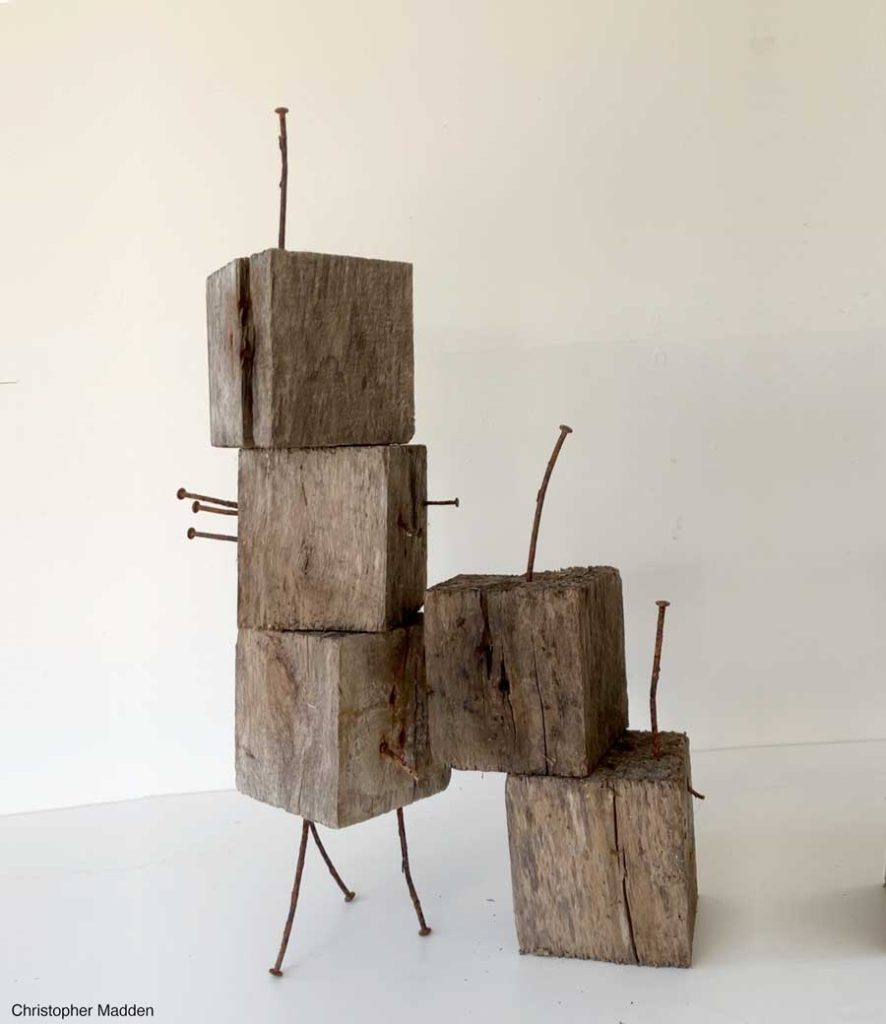
A sculpture of assemblage composed of blocks of wood and rusty nails salvaged from an old builder’s pallet.
An example of up cycling in contemporary art.

post content
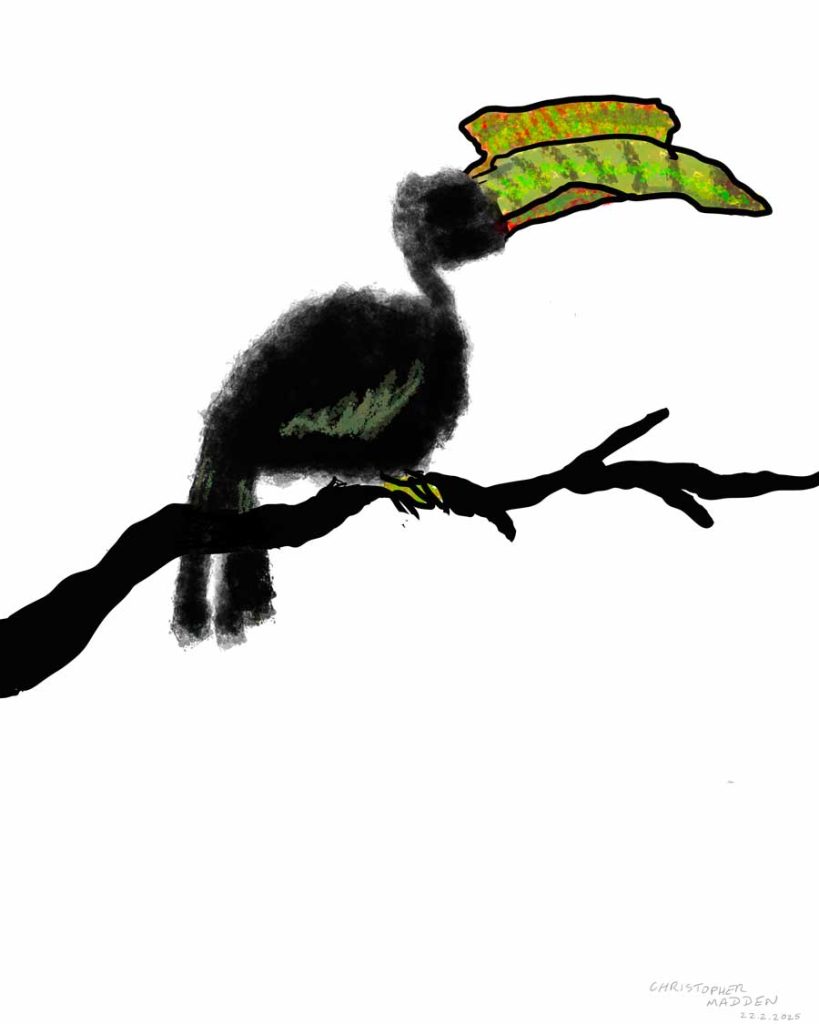
An iPad sketch in Procreate of a bird drawn from the imagination. I’ve given it a hornbill-like bill, so I suppose it’s a hornbill.
I like the dramatic effect of using strong areas of black with smaller areas of colour.
I’ve deliberately avoided giving the bird an obvious eye.
post content
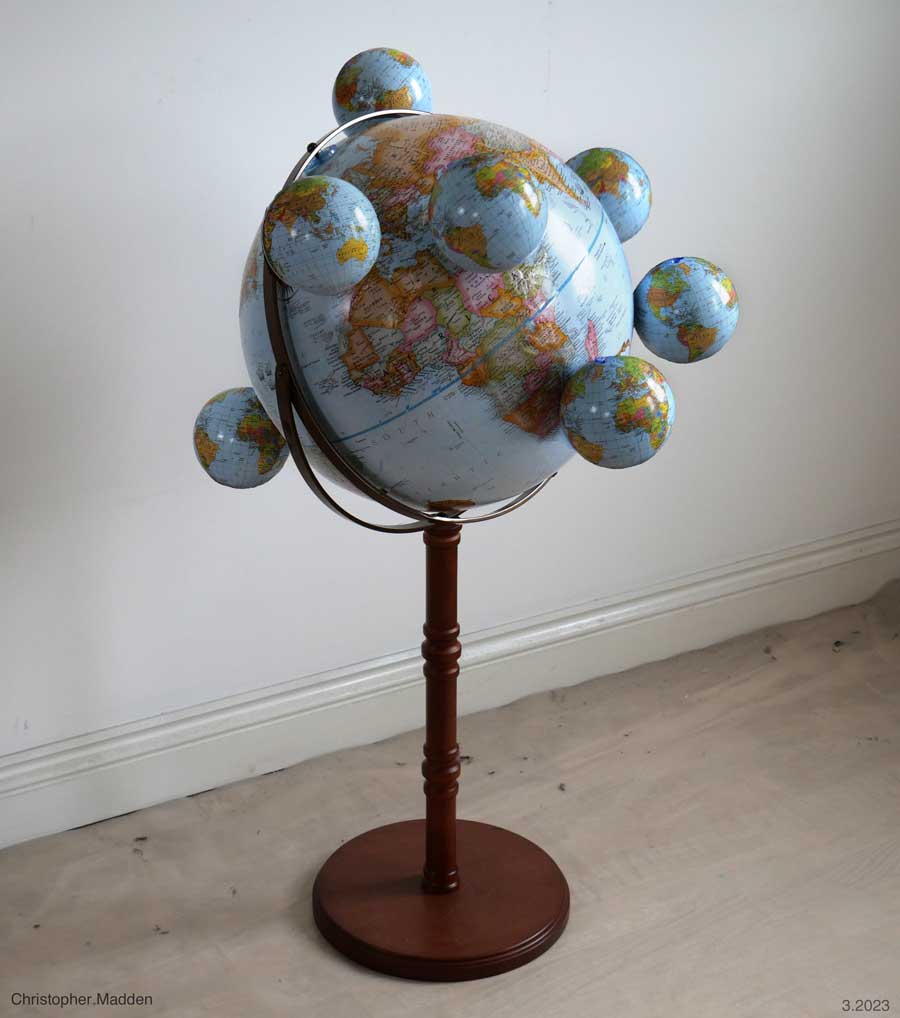
The sculpture is composed of one large globe with several smaller globes attached to it.
The use of a globe of the Earth in the sculpture reflects my interest in environmental issues and in creating environmental art. My concerns about environmentalism go back to the 1960s, when I was mainly concerned with threats to wildlife. Since then the list of environmental concerns has grown and now includes climate change, resource depletion, environmental degradation and other aspects of environmentalism.
One of several interpretations of the work is that it shows that on the one physical planet Earth there exist multiple cultural world-views.
post content

A proposal for a mural on a gallery wall based on a drawing of the Tree of Life that I created in 2008 as a pen and ink drawing.
The concept reflects my interest in environmental issues. I drew my first environmental images in the early 1970s.
The concept behind the image is that the Tree of Life, or perhaps more specifically the Tree of Evolution, has at the top of its highest branch a human being, signifying that within this concept the human being is the highest or most evolved form of life on the planet.
The concept is twisted however by the fact that in the image the human being, due to his elevated vantage point, can destroy the rest of life on earth as a direct result of his evolutionary position, with his highly evolved intelligence making him capable of designing and manufacturing guns). The Tree of Life becomes the Tree of Death.
post content
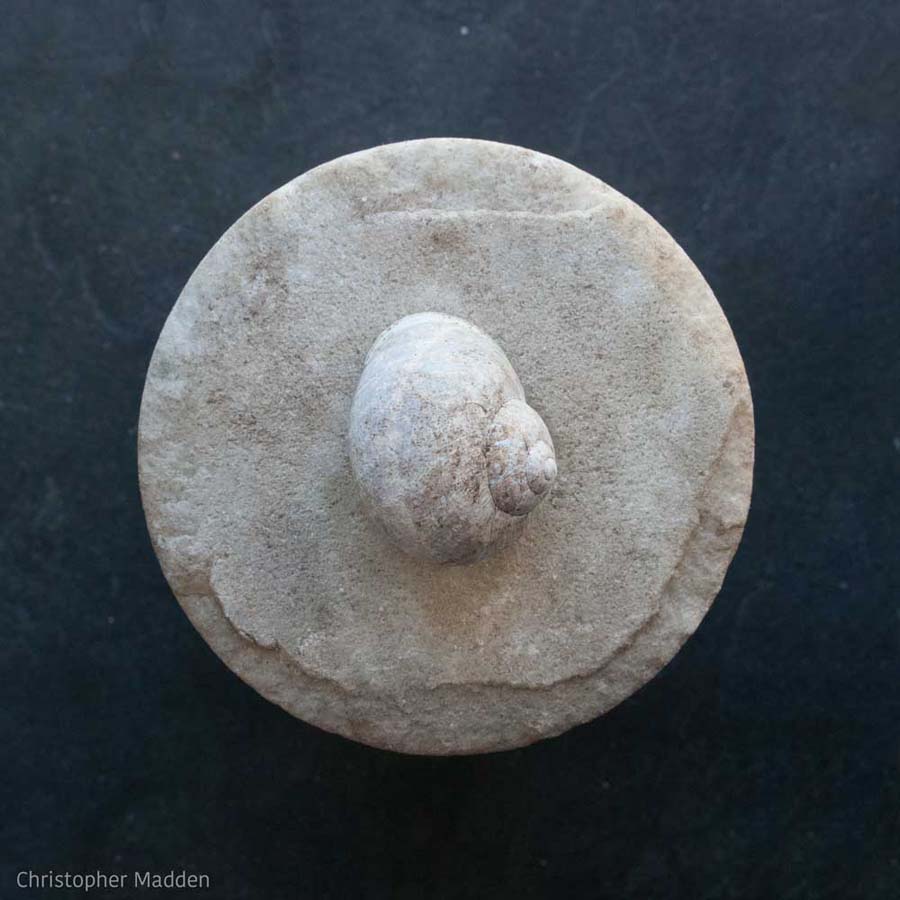
A contemporary art print of an old snail shell on the top of a cylindrical marble plinth. The snail shell has lost all of its colour due to its age and the amount of time that it had spent outside in the elements. It is now almost indistinguishable from the marble of the plinth on which it rests.
The photograph is taken from a small sculpture that I created from a snail shell found in my garden (It’s the shell of a common garden snail, cornu aspersum).
One of the things that I like about this piece is the fact that the old snail shell is incredibly fragile and light while the marble is hard and heavy, yet they both look remarkably similar on the surface. It is a piece partly concerned with the nature of superficial appearance. It’s also aesthetically pleasing, with all of those curved and rounded forms.
The fragile snail shell evokes feelings about the fragility of nature and the environment in the time of the ongoing environmental crisis.
post content
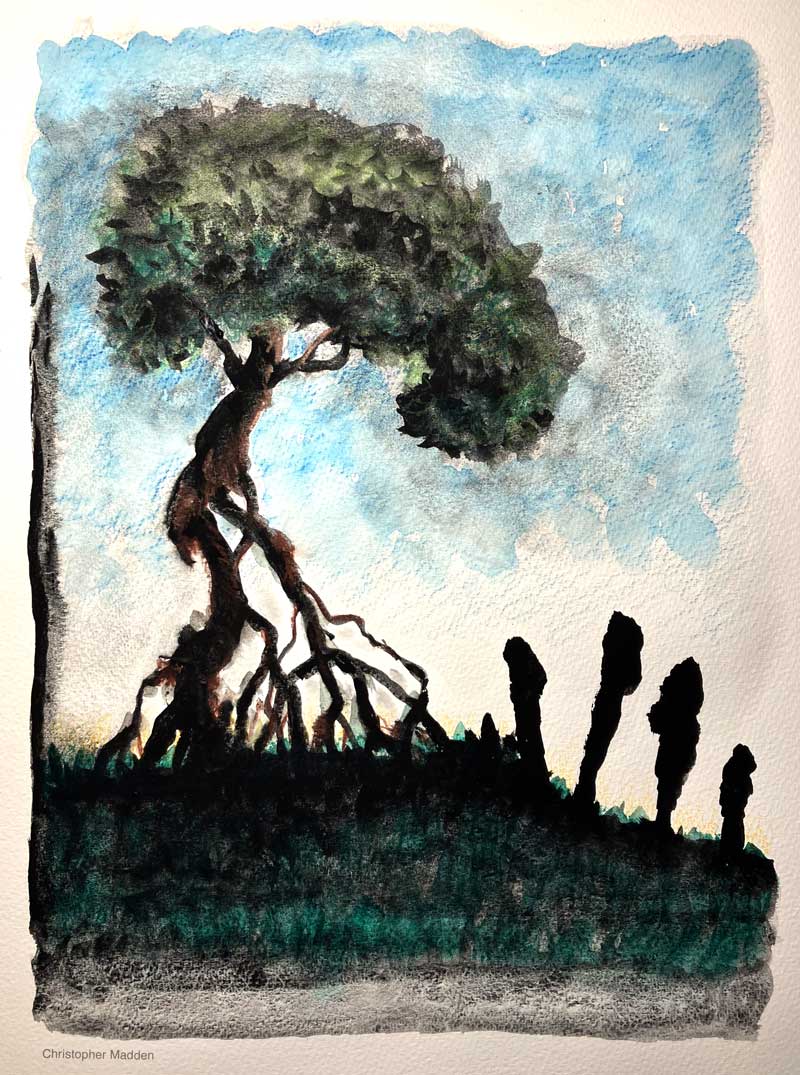
A watercolour painting from the imagination, depicting a tree in a sinister landscape. The dark foreboding atmosphere of the painting is partly to reflect the atmosphere of the ongoing environmental crisis and partly to reflect the atmosphere of thinking about it.
The tree looks as though it has uprooted itself and is trying to get away from its environment by using its roots as limbs. Alternatively, maybe the ground around the tree’s roots has been washed way as part of environmental degradation (perhaps by floods caused by climate change or by people’s exploitation of the land), literally sweeping away or undermining the foundations of a sustainable environment. And what are those objects next to the tree?
post content
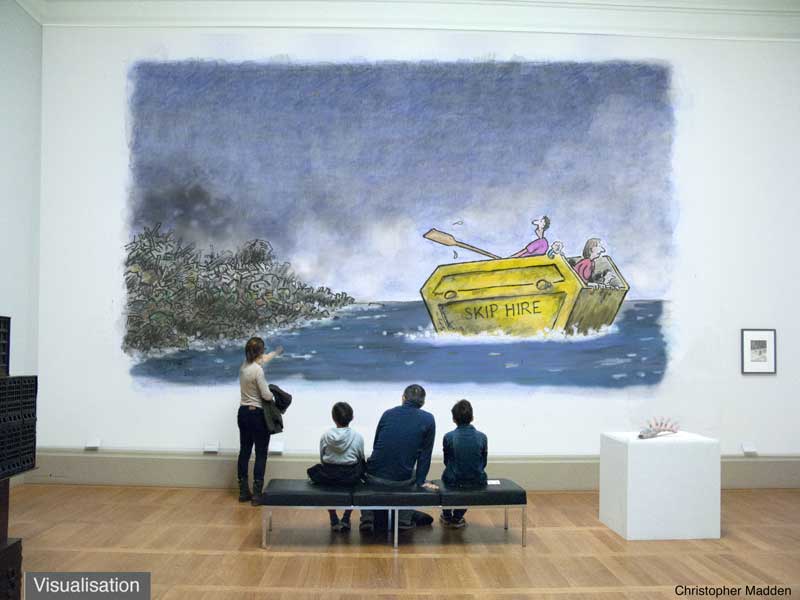
This proposed mural is based on a cartoon about fleeing environmental catastrophe that I drew in about 1991.
The image depicts a Western family fleeing a ravaged land that is piled with the detritus of the consumer society. The family is fleeing in a builder’s skip or dumpster, which ironically is a symbol of consumerism in that skips can often be seen outside houses here in the UK while the owners of the houses have new kitchens installed to replace their perfectly good old kitchens. There are several skips in my street as I write this.
When I first drew the cartoon about thirty years ago the concept of fleeing environmental disaster by boat was a novel idea with little or no link to actual events in the real world. The journey in the cartoon was symbolic. Now in the 2020s everything has changed, with boats constantly crossing the Mediterranean Sea and the English Channel carrying migrants from countries that are affected by climate change and other environmental and social pressures.
It’s interesting that if the mural depicted in this photograph was a cartoon in a magazine it would be looked at for a couple of seconds at most and then passed over. Enlarged onto a gallery wall the image may attract attention for noticeably longer and would magically attain a higher status.
I’ve drawn environmental cartoons since the 1970s. My environmental cartoons have been published widely, including in publications such as the Guardian newspaper and the Critic magazine. A book of my environmental cartoons, When Humans Roamed the Earth, was published by WWF/Earthscan in 1992.
post content
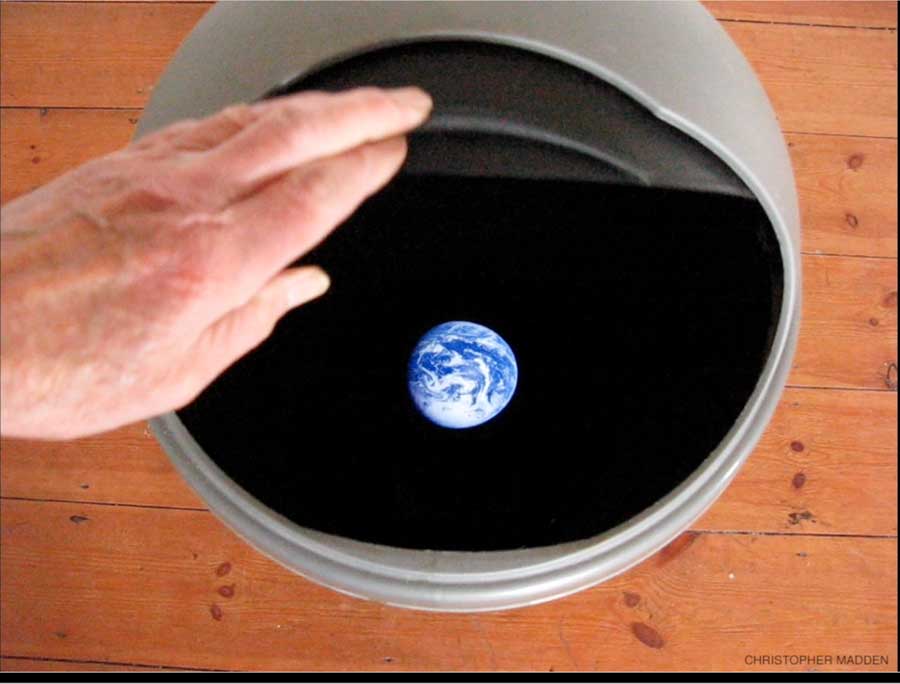
I’ve been creating environmental art in one form or another since about 1970. This work is a development of a previous work from the late 1980s.
The work is a sculpture showing how I feel the human race is treating the environment – by putting the planet into the rubbish bin.
The sculpture consists of a standard kitchen waste bin, lined internally with very matte black material and with a back-lit image of the earth at its base. The result is the illusion that by looking into the bin you are looking into outer space as though through a porthole in a spacecraft, with the earth floating in the distance. It’s surprisingly effective.
The kitchen waste bin was deliberately chosen as the reciprocal that contains the earth because of its banality, to emphasise how we are causing environmental damage by depleting the earth’s resources through mundane consumption.
A version of this work was shortlisted for the Royal Academy Summer Exhibition 2022 and was exhibited in my solo show at Tremenheere Sculpture Gardens, Cornwall, the same year.
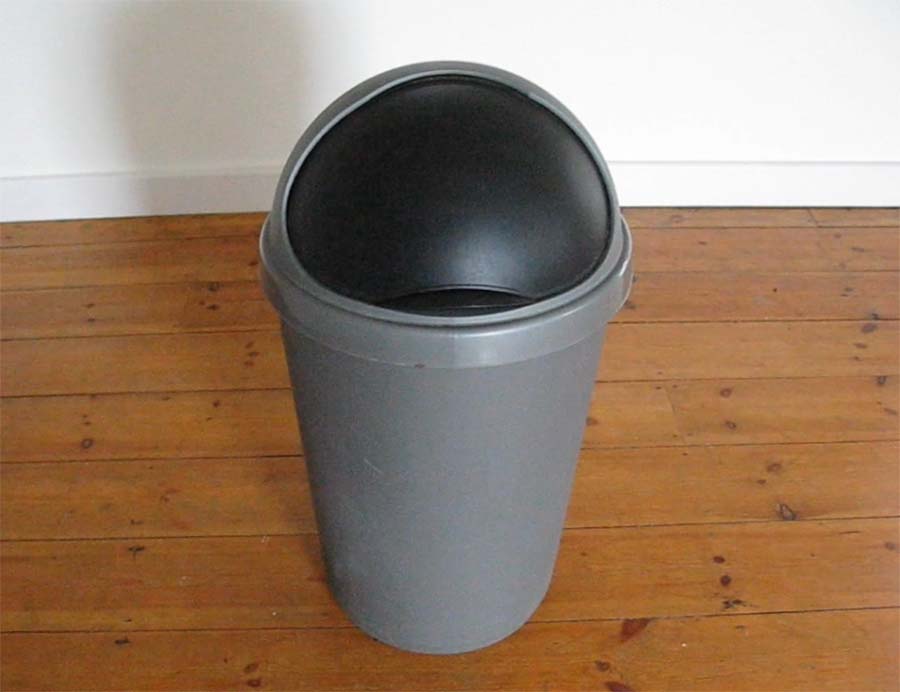
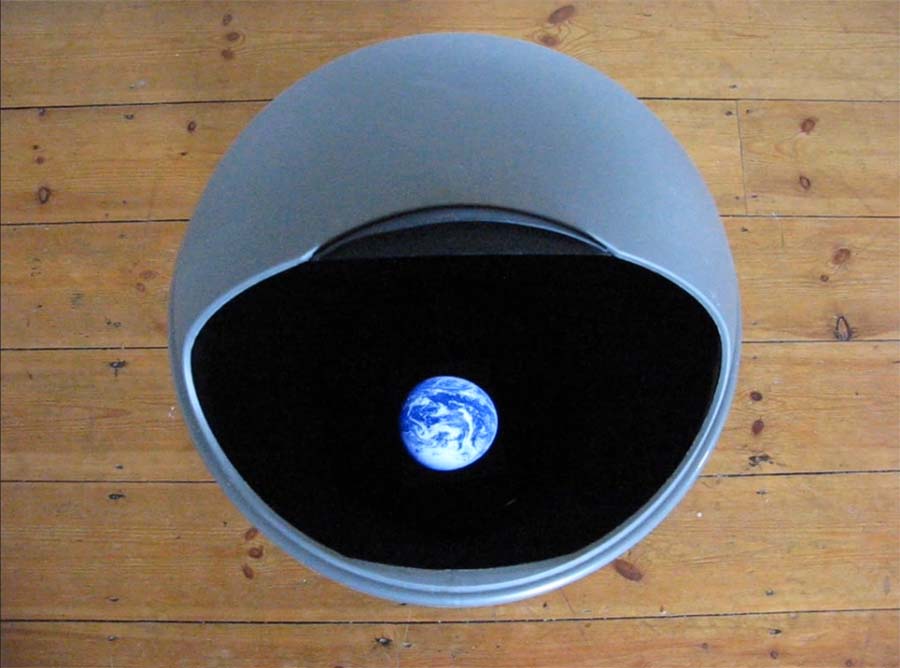
post content
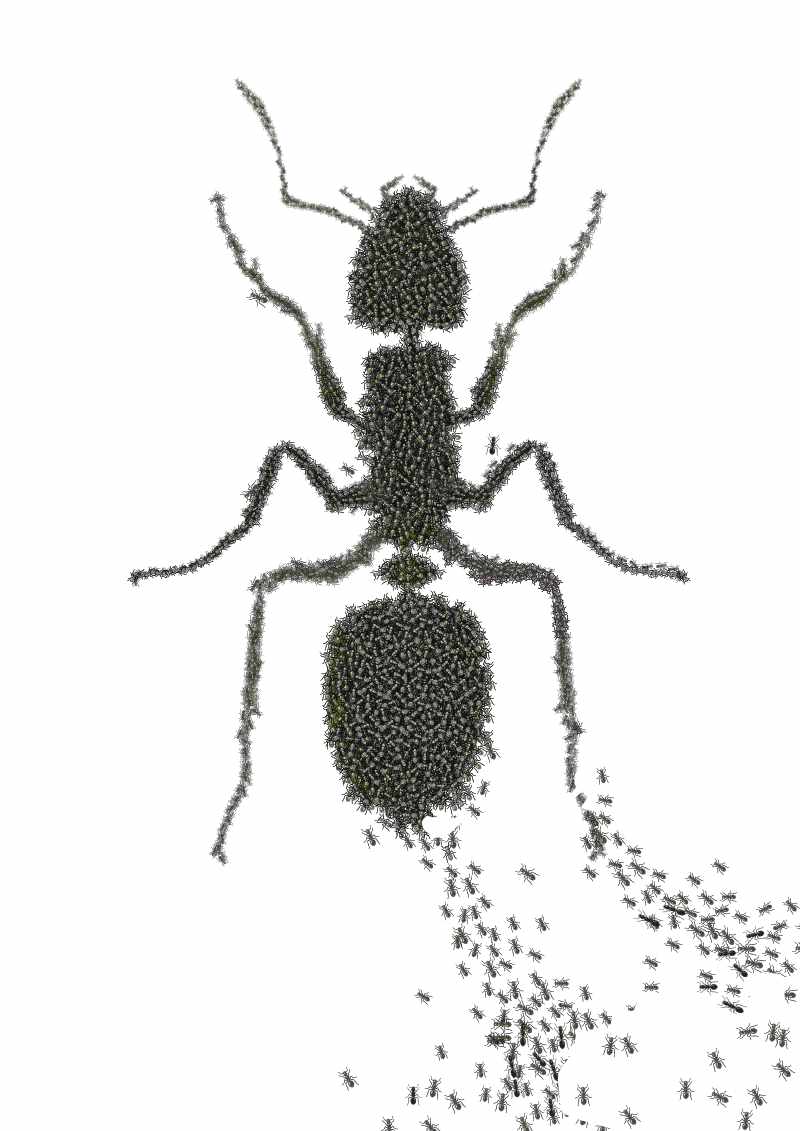
An image of a swarm of ants forming the shape of one giant ant.
The image is intended to convey the scientific concept of the superorganism, where the individual members of an animal community (often insects such as bees, wasps or ants) cannot exist as individuals but have to function as part of a larger unified communal entity.
The concept of the superorganism is similar to the concept of the hive mind. The hive mind is perhaps more closely identified with neural activity rather than physical activity, and in human society is associated with the concepts of collective consciousness, group think and other thought processes. Hive mind activities such as group think are not necessarily positive.
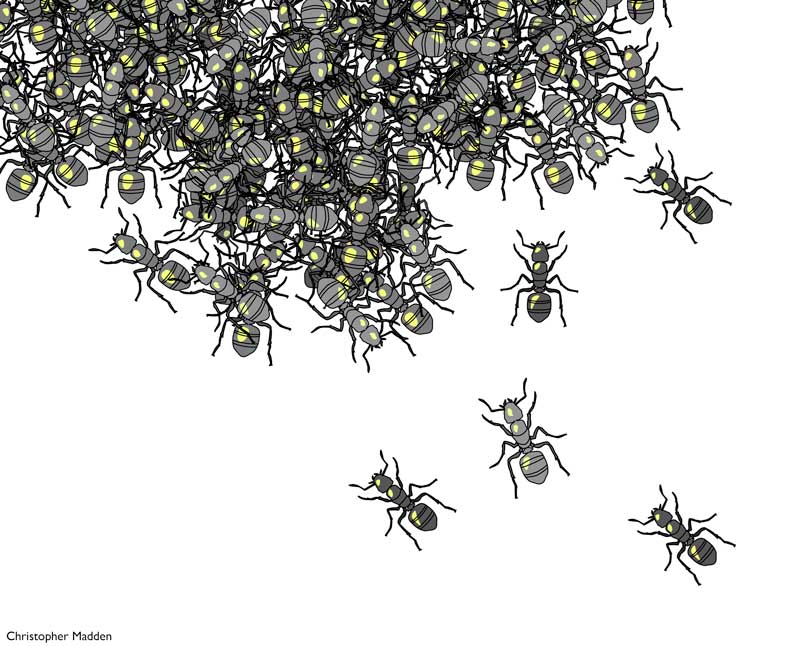
The work reflects my interest in science, evolution, the natural world and the environment. It is based on a conncept and image that I created in the 1990s for the Guardian newspaper.
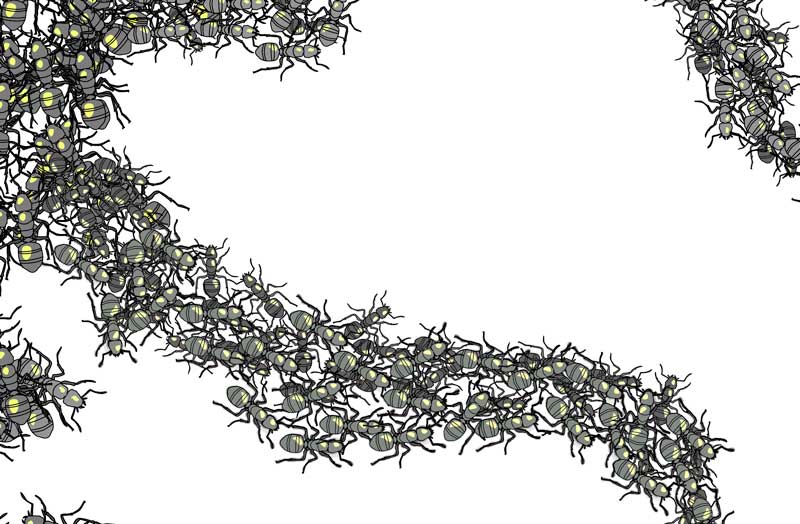
Some people argue that human society is a superorganism, generally on the grounds that we live in an incredibly complex society that is full of specialisation of roles, and that society would fall apart if some of these roles were to fail to function. This definition however doesn’t take into account one of the prerequisites of a superorganism, which is that the individual organisms within the superorganism can’t survive alone. Humans can easily survive even if our complex society collapses – there are people all around the world doing that very thing right now.
post content

An acrylic and watercolour painting of a black flower.
This painting is an example of my work relating to environmental issues, a subject with which I’ve been involved since the late 1960s.
In this painting the flower’s petals are black, the flower’s stem is black, and the grass is black. The flower’s petals are shrivelled and misshapen and the stem is crooked. It’s an image of foreboding.
In contrast to all this blackness the centre of the flower is reflective gold. But it’s a dull gold, which may act to reinforce the bleakness of the black rather than creating a glimmer of brightness. It’s ambiguous.
The gold centre to the flower and the spiky petals give a hint of a dying sun or star, with the accompanying implications for life on earth (such as the flower). It’s a dying sunflower.
post content
A video camera moves towards a builder’s skip and travels through a hole in the tarpaulin that covers the skip to reveal the contents of the skip.
The contents are seen to be a view of outer space with planet Earth suspended or floating in it. The builder’s skip may be thought of as a portal to another dimension.
A meaning of the artwork is that the Earth has been reduced to the rubble and rubbish that is disposed of in builder’s skips or dumpsters, which are primarily designed to hold the debris and waste from construction projects and demolition projects. The work is a critique of our disposable consumer society and the environmental crisis that we are currently living through. In the area of London in which I live there are frequently builder’s skips positioned on the road in front of houses as the owners rip out perfectly good kitchens and replace them with new kitchens. It’s happening just a few doors away right now.
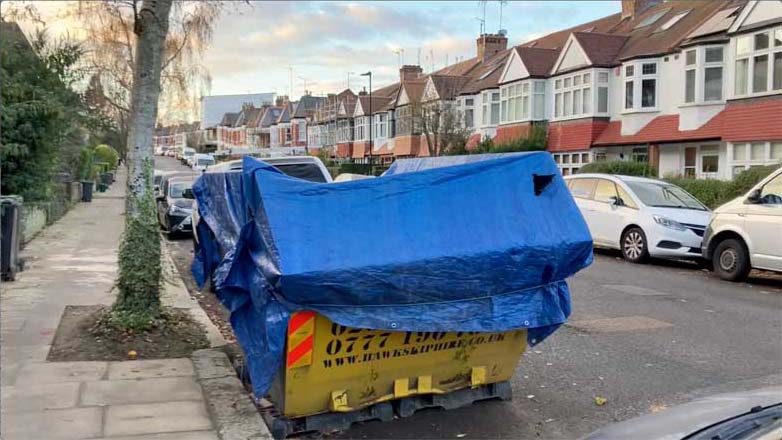
post content
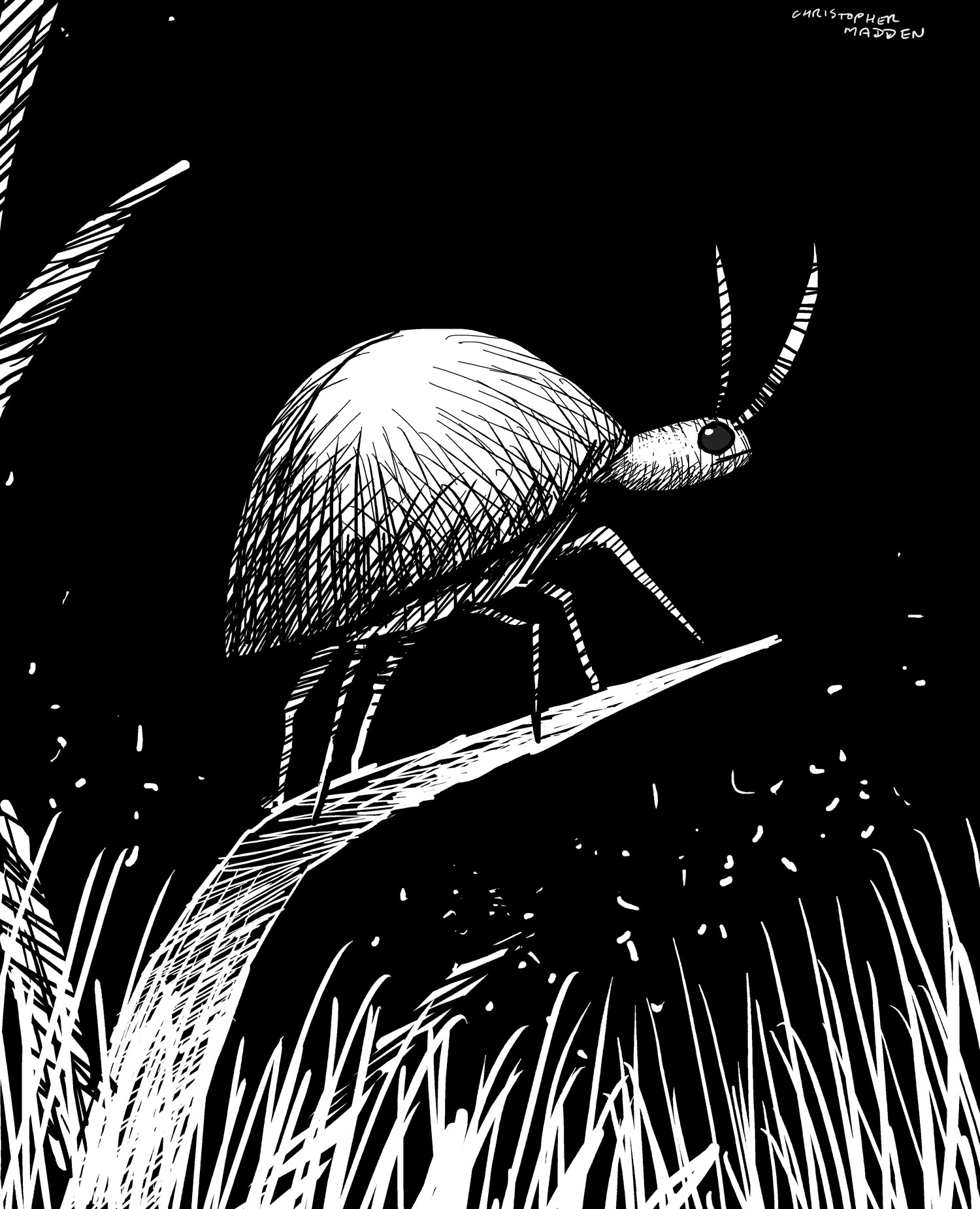
A digital sketch created for a print. It features a stylised insect drawn from my imagination.
The insect is drawn in a sketchy black and white style that is perhaps suggestive of images produced using traditional printmaking techniques such as woodcut, woodblock or linocut. It also reminds me of scraper board.
The black sky makes me think that it’s a nocturnal insect of some kind. It also looks a bit like a tortoise for some reason, with perhaps a bit of rhinoceros thrown in.
post content
Note: this work has coincidental similarities to House Taken by Rafael Gomezbarros.
My concept predates that of Gomezbarros, mine being originally conceived in the 1990s to accompany an article in the Guardian newspaper, while Gomezbarros’s work was created in the 2000’s (as far as I can tell).
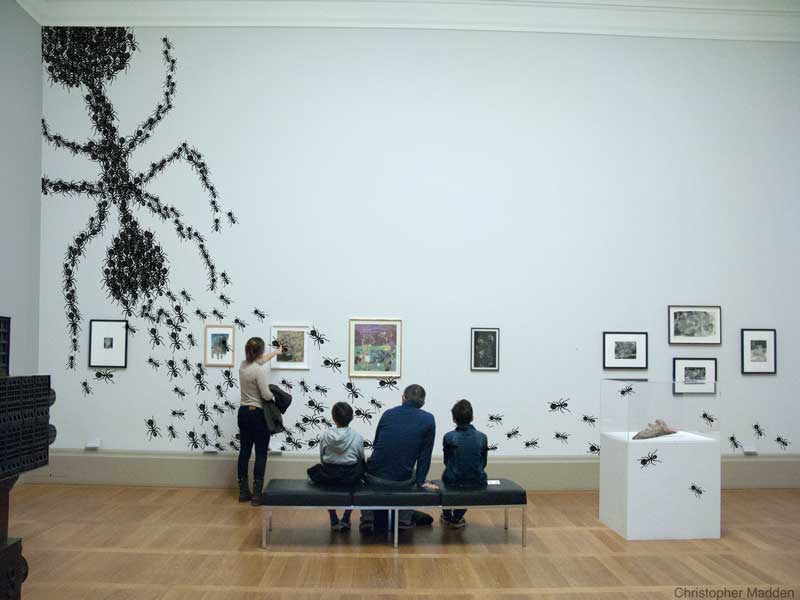
A proposal or concept for an artwork showing ants crawling across an art gallery wall, with the ants grouping together and coalescing into the form of a single gigantic ant.
The artwork depicts the concept of the superorganism, in which multiple individual organisms of the same species (in this case ants) interact by a process of synergy to give rise to a collective body that can operate in ways that the individuals can’t. The individual organisms within the superorganism usually display a degree of division of labour or specialisatoin of function, meaning that the individual organisms can’t survive for long on their own. Human civilisation is often defined as a form of superorganism, although this isn’t strictly accurate, as humans can survive alone.

The ants in the work may be two dimensional, such as in a mural, or three dimensional such as in a sculptural work.
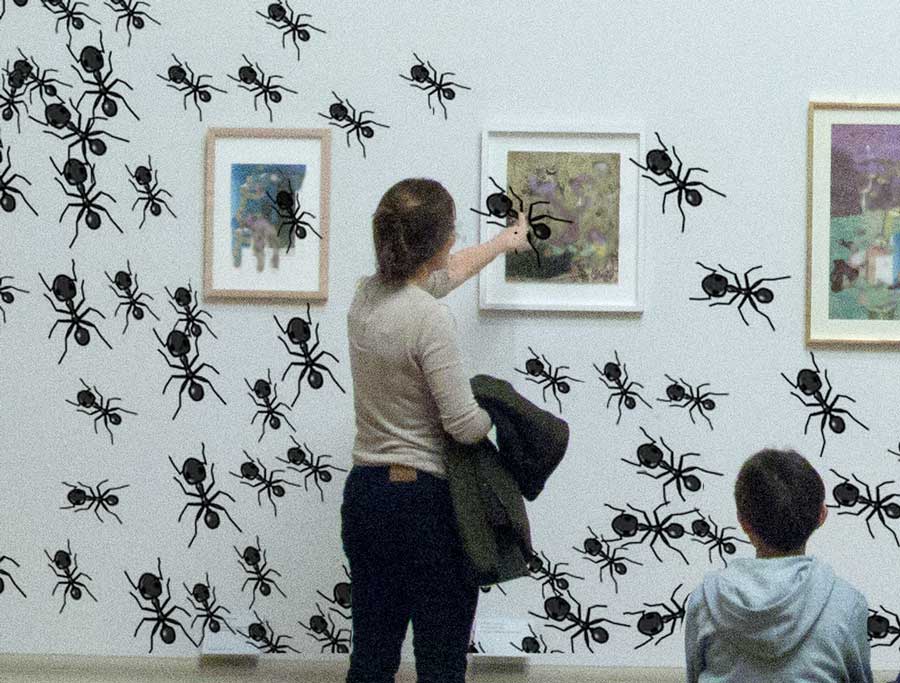
post content
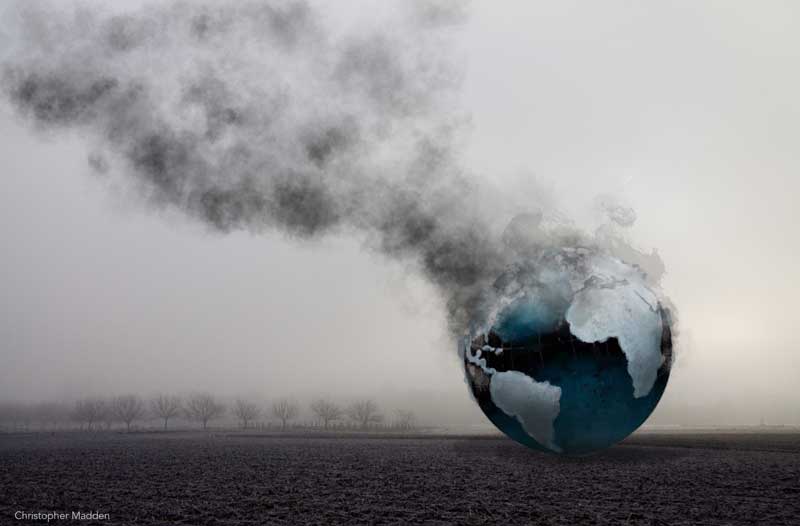
A smoking globe. Planet Earth suffering the consequences of climate change or global warming.
The globe in the image is resting on the ground rather than floating in space. It may be a giant sculpture of the earth smouldering as a result of climate change. It also has the appearance of being some sort of crashed or abandoned man-made structure, as though the earth is an artificial artefact, which in many ways it is, and that this is the reason for its stricken state.
The globe is resting on the ground in a very large field. In the background is a row of trees. These trees give a hint towards the existence of nature and the natural world, however on a second look it may be noticed that the trees themselves are in a perfectly straight line and are all the same age and species – they are in fact part of a completely man-made landscape.
This is one of my many works dealing with environmental issues such as climate change and global warming.
post content
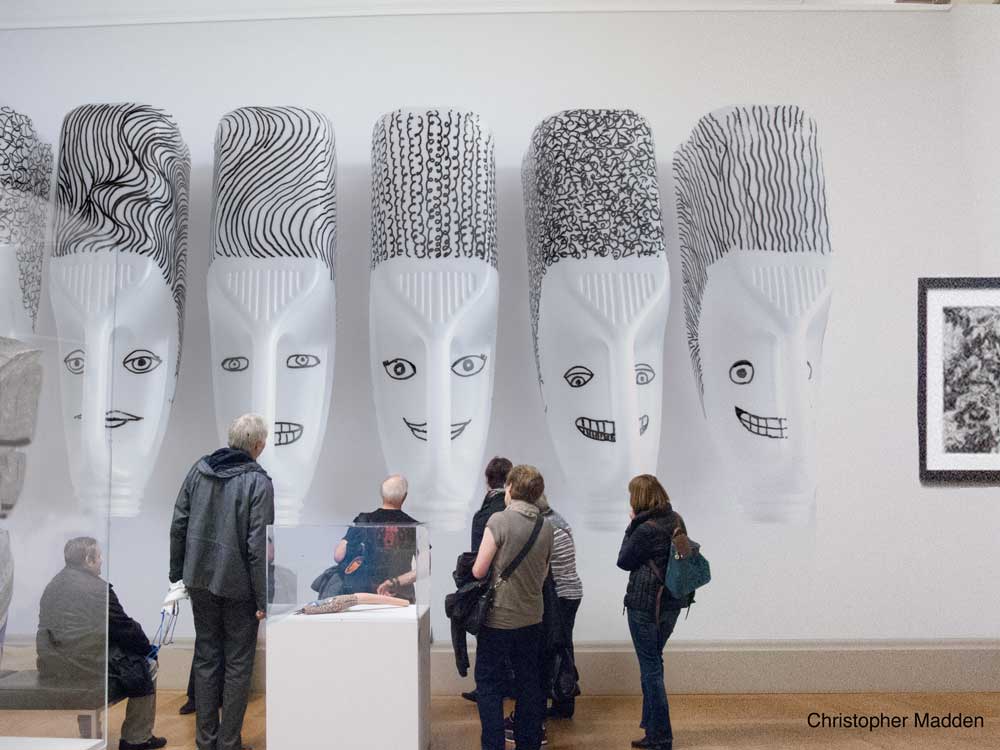
This visualisation is a development of my work in creating human heads from plastic milk bottles.
The sculptural heads are vastly over-sized compared to the original plastic milk bottles.
The size of the heads gives them an impressive air, similar to that created by, for example, Easter Island statues. The primitive markings that create the faces are reminiscent of ancient ritualistic statuary. These factors, the ancient and the impressive, give the work a tension due to the mundanity of the objects that are actually represented – discarded plastic milk bottles with fibre tip pen faces drawn on them.
These heads are partly a comment on our throw-away consumer culture and the environmental hazard that it represents. The size of the milk bottles can be taken to represent the size of the problem of consumer waste, especially of one-use consumer waste (such as plastic milk bottles). The faces drawn on the bottles are partly a reference to the fact that it’s normal people who are generating the waste.
The work reflects my interest in art and the environment (I created my first environmental art in the early 1970s).
post content
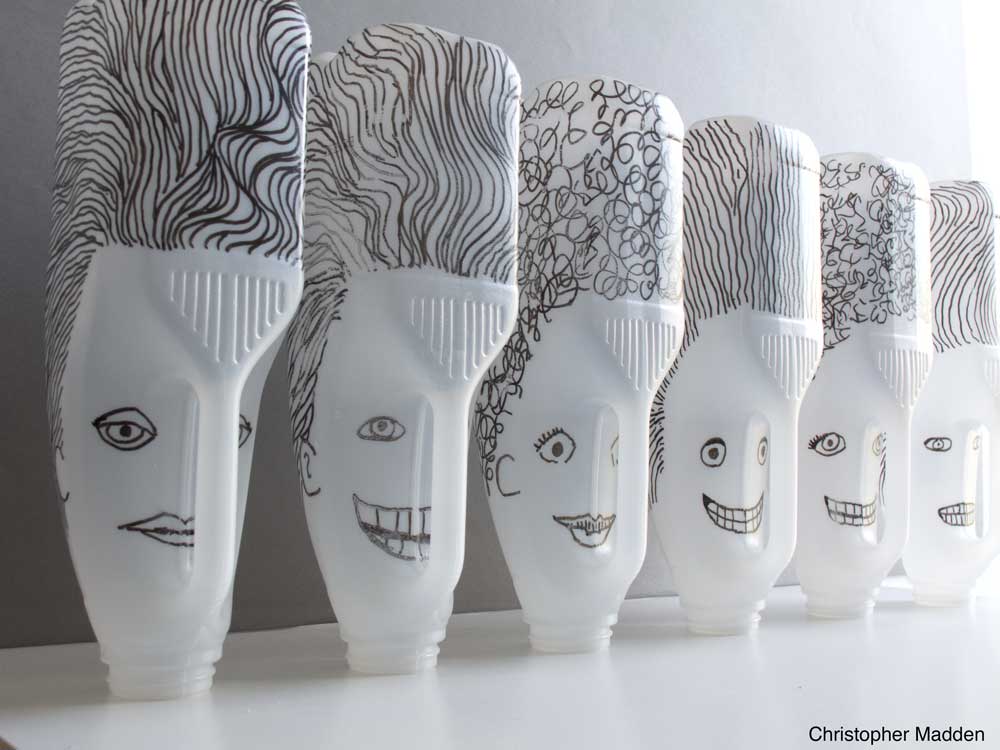
Plastic milk bottles with human heads drawn onto them.
These heads are an example of art created from rubbish. Their recycled nature is partly an observation on our throw-away consumer culture.
The bottles are surprisingly head-shaped, reminding me somewhat of various non-Western forms of sculpture. I particularly like the way that the milk bottle handles make very interesting and bizarre noses.
I’m in the process of making several dozen of them, as their impact is increased as their numbers increase.
post content
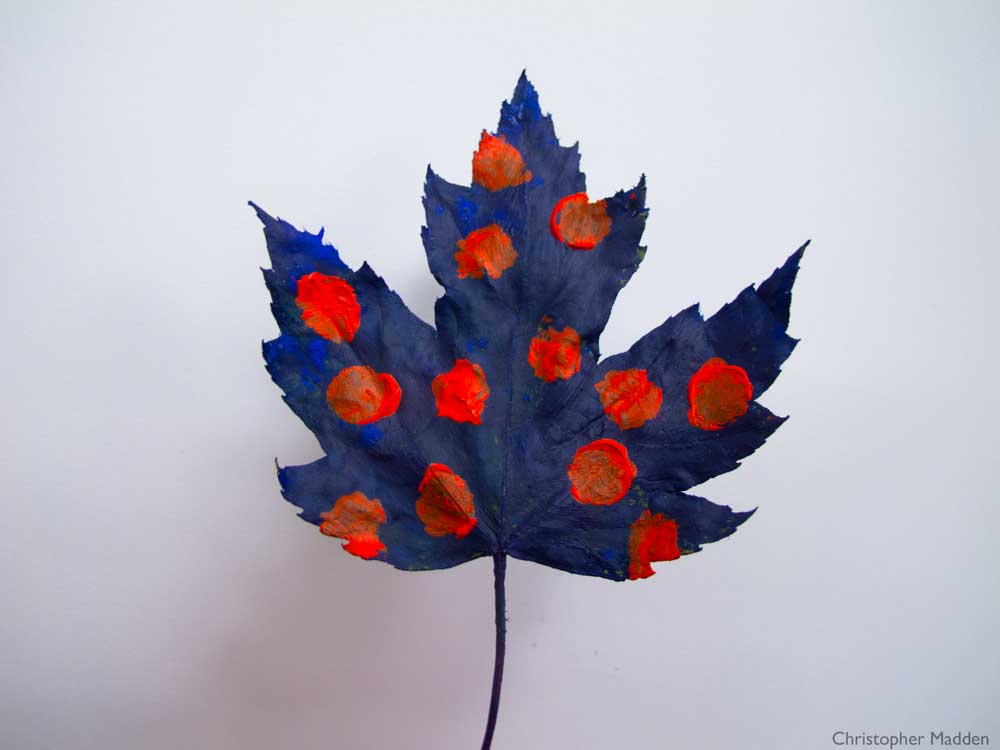
A maple leaf painted blue with red polka dots.
The leaf had fallen from the tree in autumn.
The inspiration for this work came partly from the fact that the leaves on the trees were changing colour in the autumn, prompting me to think of changing their colours in other ways.
In previous years I’ve painted acorns and suchlike in unusual colours.
Like a lot of my work, this work involved interacting with and responding to the natural environment.
Unlike a lot of environmental art, my own environmenntal art often involves interventions of a deliberately unnatural nature, such as here where I’ve painted a perfectly nice autumn leaf in unnatural paint (acrylic) and in a design generated from human esthetics. This is partly to convey the way that we impose our tastes and our values on the natural world.
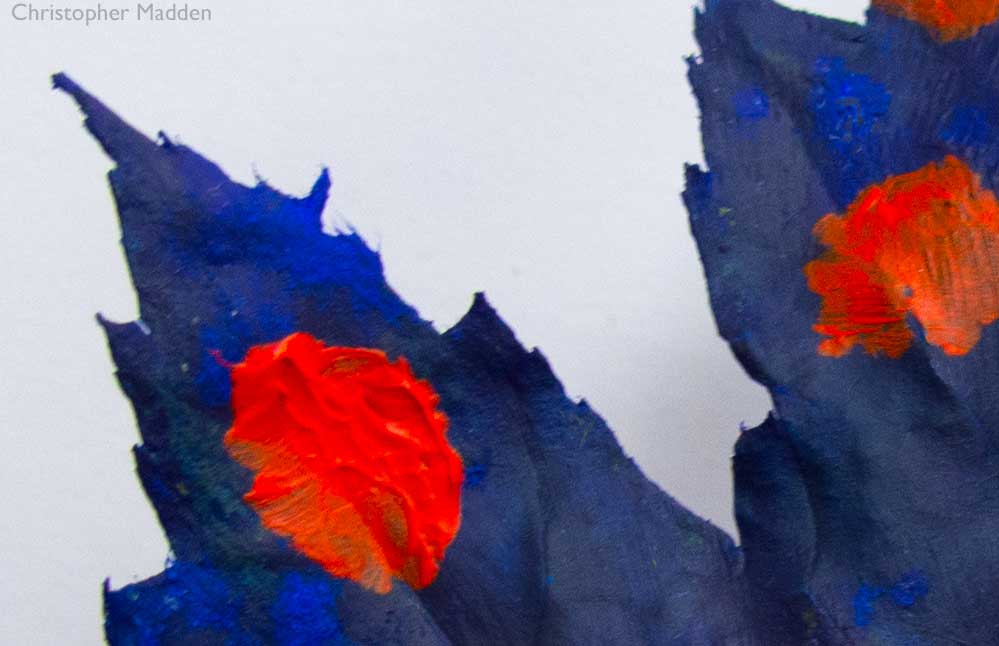
post content

A work consisting of an umbrella clinging limpet-like to a granite rock on a hilltop in Cornwall.
post content

Slightly unsettling heads created from empty plastic milk bottles.
Like many artists I have a habit of collecting waste and recycling it into works of art.
The slightly sinister appearance of these heads, drawn as they are on post-consumer waste in the form of discarded plastic milk bottles, can be interpreted as a comment on the fact that we as humans are destroying the environment through (amongst other things) our profligate use of plastic packaging (I’ve been producinng work connserned with environmental issues since the 1970s).
The fact that the heads also resemble the type of craft-play objects produced by children can be interpreted as alluding to the western world’s current tendency towards a philosophy of consequence-denying pleasure seeking in which the adults in society fail to take responsibility for their actions beyond immediate self-gratification.

post content

A work of environmental art consisting of an umbrella clinging to a granite rock on a misty hilltop in Cornwall.

The umbrella in this work of contemporary environmental art or land art can be seen as representing shelter. Perhaps it’s shelter from bad weather caused by climate change or global warming. Umbrellas after all are primarily designed to provide shelter from the weather. The shelter provided by the umbrella in the face of climate change is however woefully inadequate. An umbrella after all is a very flimsy structure.
post content